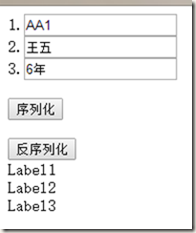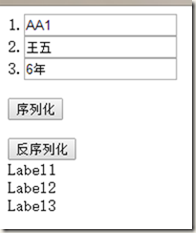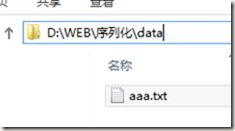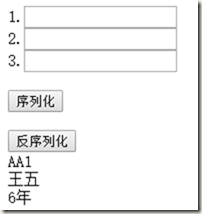序列化:把对象转化成流,流转化成文件、二进制。
反序列化:把流转化为对象。
序列化需要引用流、序列化两个类,
using System.Runtime.Serialization.Formatters.Binary;
using System.IO;
还需要创建一个类(对象),
stuDA类(封装了3个变量code、name、nation):
using System; using System.Collections.Generic; using System.Linq; using System.Web; [Serializable]//标记为可序列化 /// <summary> /// stuDA 的摘要说明 /// </summary> public class stuDA { public stuDA() {
} private string code; public string Code { get { return code; } set { code = value; } } private string name; public string Name { get { return name; } set { name = value; } } private string nation; public string Nation { get { return nation; } set { nation = value; } } }
注意:以上代码中加粗部分,[Serializable]重要语句,将这个类标记为可序列化,否则将会报错。
新建页面,并添加控件:
序列化按钮代码:
//序列化按钮 protected void Button1_Click(object sender, EventArgs e) { stuDA ss = new stuDA { Code = TextBox1.Text, Name = TextBox2.Text, Nation = TextBox3.Text }; FileStream fs = null; try { string path = Server.MapPath("data/aaa.txt");//映射服务器端的硬盘物理路径 fs = new FileStream(path, FileMode.Create);//建立文件流 BinaryFormatter bf = new BinaryFormatter();//二进制转换器 bf.Serialize(fs, ss);//把对象序列化为给定流 } finally { if (fs != null) { fs.Close();//流使用后必须关闭。 } } }
反序列化按钮代码:
//反序列化按钮 protected void Button2_Click(object sender, EventArgs e) { string path = Server.MapPath("data/aaa.txt"); FileStream fs = null; try { fs = new FileStream(path, FileMode.Open);//使用流打开文件 BinaryFormatter by = new BinaryFormatter();//二级制转化器 stuDA sdata = (stuDA)by.Deserialize(fs);//反序列化成对象 Label1.Text = sdata.Code; Label2.Text = sdata.Name; Label3.Text = sdata.Nation; } finally { if(fs!=null) { fs.Close(); } } }
在三个文本框中分别输入字母或汉字,点击序列化:
注意:文件将会生成在该网站的目录下 data文件中,data文件需要预先创建。
打开文件可以看到一些略有规律的乱码(因为使用二进制的关系):
清空文本框的内容,点击反序列化:




